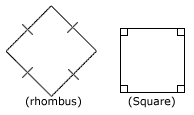Solved Examples and Worksheet for Sharing of Attributes by Different Categories of Quadrilaterals
A. parallelogram
B. triangle
C. square
D. rectangle
Step: 1
The quadrilaterals parallelogram, square and a rectangle have two pairs of parallel sides each.
Step: 2
Angles in a square and a rectangle are right angles.
Step: 3
Parallelogram is the quadrilateral that has two pairs of parallel sides and does not have right angles.
Correct Answer is : parallelogram
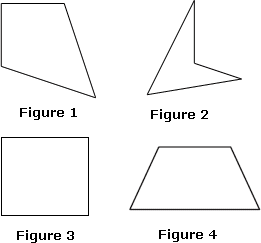
A. Figure 3
B. Figure 4
C. Figure 1
D. Figure 2
Step: 1
The lines, which never meet are called parallel lines.
Step: 2
Amongst the figures, Figures 1 and 2 have no parallel lines.
Step: 3
Figure 4 has only one pair of parallel lines.
Step: 4
Figure 3 has 2 pairs of parallel lines.
Correct Answer is : Figure 3
A. rhombus
B. rectangle
C. parallelogram
D. square
Step: 1

Step: 2
A quadrilateral with both pairs of opposite sides parallel is always a parallelogram.
[By definition.]
Step: 3
It can be a rhombus, a rectangle or a square under special conditions, but not always.
Correct Answer is : parallelogram
A. rhombus
B. square
C. rectangle
D. trapezoid
Step: 1
For a rhombus, all the sides are equal in length and only the opposite angles are equal. So, the parallelogram described cannot be a rhombus.
Step: 2
Only the opposite sides of a rectangle are equal in length. So, the parallelogram described cannot be a rectangle.
Step: 3
Trapezoid is not a parallelogram.
Step: 4
A square has all its sides of equal length and every angle is a right angle.
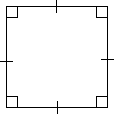

Step: 5
So, the parallelogram described is a square.
Correct Answer is : square
I. It has two pairs of parallel opposite sides.
II. It has all its sides congruent.
III. It has four right angles.

A. I and II
B. I, II, and III
C. II only
D. I only
Step: 1
The statement "It has two pairs of parallel opposite sides" could mean a square or a rectangle or a parallelogram or a rhombus. The answer is ambiguous.
Step: 2
The statement "It has all its sides congruent" could suggest a square or a rhombus. Still the answer is ambiguous.
Step: 3
The statement "It has four right angles" is ruled out as a rhombus doesn't contain a right angle.
Step: 4
So, among the statements given, I and II together imply that the figure shown is a rhombus.
[Combining all the three statements we would get a square.]
Correct Answer is : I and II
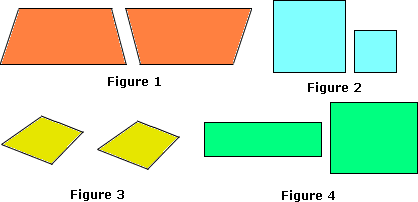
A. Figure 4
B. Figure 2 and Figure 4
C. Figure 1 and Figure 3
D. Figure 2
Step: 1
If the quadrilaterals are of same shape and size, then the quadrilaterals are said to be congruent quadrilaterals.
Step: 2
The pair of quadrilaterals in Figure 1 and Figure 3 have same size and shape.
Step: 3
The pair of quadrilaterals in Figure 2 and Figure 4 does not have same shape and size.
Step: 4
So, the pair of quadrilaterals in Figure 2 and Figure 4 are not congruent.
Correct Answer is : Figure 2 and Figure 4

A. I, II, and III
B. I and II
C. I and III
D. II and III
Step: 1
In a parallelogram any two opposite sides are equal.
Step: 2
A rectangle is a parallelogram.
Step: 3
So the properties that are true for a parallelogram are also true for a rectangle.
Step: 4
That means in a rectangle also any two opposite sides are equal.
Correct Answer is : I and II
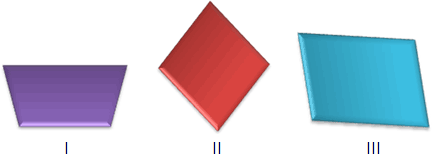
A. I
B. III
C. II
D. II and III
Step: 1
The given quadrilaterals are trapezoid, rhombus, and parallelogram.
Step: 2
In a parallelogram, both pairs of opposite sides are parallel.
Step: 3
Rhombus is a parallelogram since all the properties that are true for a parallelogram are also true for a rhombus.
Step: 4
So, in a rhombus, both pairs of opposite sides are parallel.
Step: 5
In a trapezoid, only one pair of opposite sides is parallel.
Step: 6
Therefore the correct choice is trapezoid.
Correct Answer is : I
- Identifying and Locating Ordered Pairs-Gr 5-Solved Examples
- Identifying Points, and Describing Paths on a Coordinate Plane-Gr 5-Solved Examples
- Two-dimensional Geometric Figures-Gr 5-Solved Examples
Related Worksheet
- Quadrilateral
